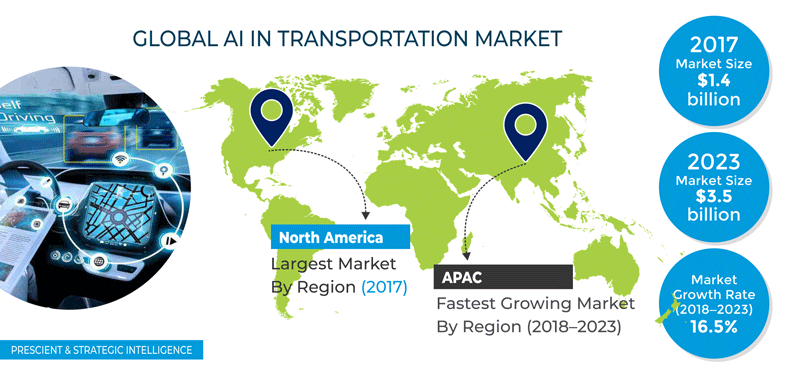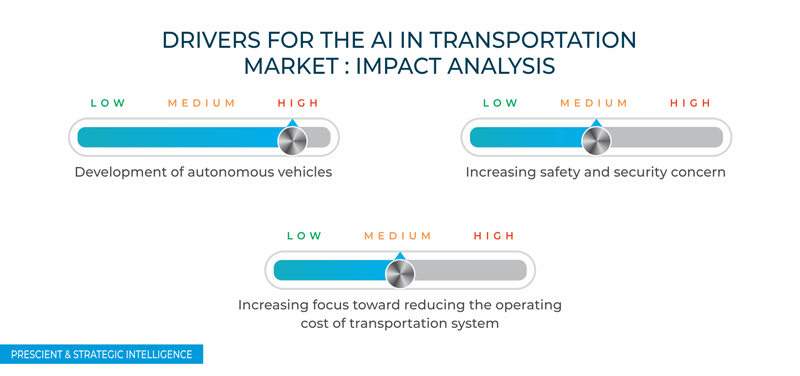Report Code: 11466 | Available Format: PDF | Pages: 220
Artificial Intelligence (AI) in Transportation Market by Offering (Software, Hardware), by Application (HMI, ADAS), by Technology (Deep Learning, Computer Vision, NLP), by Process (Signal Recognition, Data Mining), by Geography (U.S., Canada, Germany, U.K., France, China, Japan, India, South Korea, Russia, Brazil) - Global Market Size, Share, Development, Growth, and Demand Forecast, 2013-2023
- Report Code: 11466
- Available Format: PDF
- Pages: 220
- Report Description
- Table of Contents
- Market Segmentation
- Request Free Sample
Valued at $1.4 billion in 2017, the global artificial intelligence (AI) in transportation market is projected to reach $3.5 billion by 2023, witnessing a CAGR of 16.5% between 2018 and 2023.
Among all the regions, North America is expected to continue to be the largest region in the AI in transportation market during the forecast period. Trucks possess the major share in the transportation sector in the U.S. The increasing investments in autonomous trucks and regulatory developments related to compliance, safety, and accountability (CSA), in the country are expected to make North America the largest region in the global market.

Dynamics of AI in Transportation Market
The key trend being observed in the AI in transportation market is consolidation and the rising number of partnerships among the market players. For instance, in February 2018, Continental and NVIDIA announced that they are partnering to create AI-powered self-driving vehicle systems based on the NVIDIA DRIVE platform, with a planned market introduction in 2021, for level 3 features. Moreover, that month, Scania entered in a technology partnership with Haylion Technologies to develop solutions for public transport by electrified, autonomous, and connected buses.
The development of autonomous vehicles is a major driving factor driving the growth in the AI in transportation market. AI is a key technology for autonomous driving systems, as it is the only technology that enables reliable and real-time recognition of objects around the vehicle. Currently, there are significant investments coming in the automotive industry, specifically for the optimization of the self-driving technology, by major vehicle original equipment manufacturers (OEM). For instance, in November 2017, Tesla Inc. unveiled a sleek electric semi-truck with semi-autonomous capabilities. Thus, the development of autonomous vehicles integrated with smart features is expected to propel the growth of the market globally, in the long term.

Segmentation Analysis of AI in Transportation Market
When segmented on the basis of offering, the software category accounted for the larger share in the AI in transportation market in 2017, mainly because of the increasing use of software as a service platform (such as the Microsoft Azure) in human–machine interface (HMI) applications.
Based on application, HMI is expected to account for the larger share in the AI in transportation market. It is mainly due to its higher penetration of HMI in trucks compared to advanced driver-assistance systems (ADAS) systems. However, ADAS is expected to penetrate the transportation sector at the higher rate during the forecast period.
Geographical Analysis of AI in Transportation Market
Asia-Pacific (APAC) is expected to witness the fastest growth during the forecast period. It is mainly due to the highest sale of trucks in the region and the rapidly growing use of AI in transportation in countries such Japan and China. Japan is expected to be the fastest growing country in the AI in transportation market in the Asia-Pacific, during the forecast period. In the maturing Japanese truck market, companies are finding new revenue streams by integrating AI-enabled features in trucks, which, in turn, is further supporting the fast growth of APAC.
Competitive Landscape of AI in Transportation Market
Globally, AI in transportation market has a few players holding the major share. However, recently, many players have emerged in the field of AI with advanced technologies, leading to increased competition in the market. The market is currently seeing the use of AI in transportation by the companies such as Daimler AG, Volvo Group, Scania Group, PACCAR Inc., Robert Bosch GmbH, Valeo SA, NVIDIA Corp., Intel Corp., and Continental AG.
Recent Strategic Developments of AI in Transportation Market
In February 2018, Continental and NVIDIA, two of the most prominent players in the global AI in transportation market, announced a partnership to create AI-powered self-driving vehicle systems based on the NVIDIA DRIVE platform, with a planned market introduction in 2021, for level 3 features. The partnership will enable the production of AI computer systems that scale from automated level 2 features, through full level 5 self-driving capabilities, where the vehicle has no steering wheel or pedals.
Moreover, in June 2017, Valeo launched a global research center for AI and deep learning, named Valeo.ai, dedicated to automotive applications. By launching Valeo.ai, Valeo aims to host an open-community network dedicated to the development of state-of-the-art automotive applications, integrated with artificial intelligence and deep learning.
Key Questions Answered in the Report
- What is the current scenario of the AI in transportation market?
- What are the emerging technologies for the development of the AI in transportation market?
- What is the historical and the present size of the categories within the market segments and their future potential?
- What are the major catalysts for the market and their expected impact during the short, medium, and long terms?
- What is the share of different technologies of AI in transportation industry in different regions?
- What are the evolving opportunities for the players in the market?
- Which are the key regions from the investment perspective?
- What are the key strategies being adopted by the major players to expand their market share?
Want a report tailored exactly to your business strategy?
Request CustomizationWant an insight-rich discussion with the report author?
Speak to AnalystOur dedication to providing the most-accurate market information has earned us verification by Dun & Bradstreet (D&B). We strive for quality checking of the highest level to enable data-driven decision making for you
Our insights into the minutest levels of the markets, including the latest trends and competitive landscape, give you all the answers you need to take your business to new heights
With 24/7 research support, we ensure that the wheels of your business never stop turning. Don’t let time stand in your way. Get all your queries answered with a simple phone call or email, as and when required
We take a cautious approach to protecting your personal and confidential information. Trust is the strongest bond that connects us and our clients, and trust we build by complying with all international and domestic data protection and privacy laws